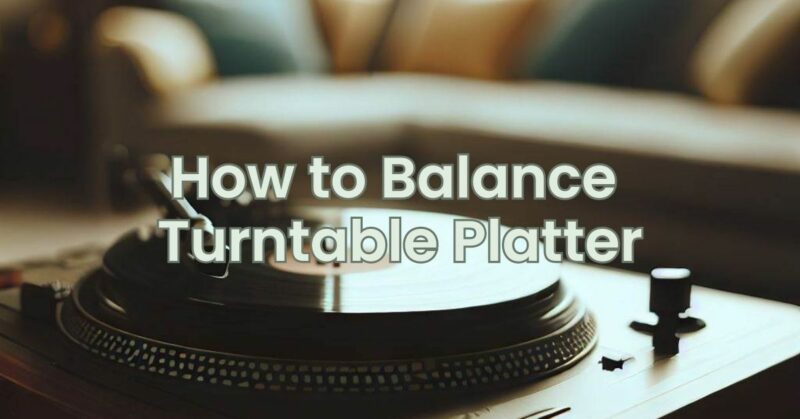Properly balancing the platter of your turntable is crucial for optimal performance and sound quality. An imbalanced platter can lead to issues such as uneven playback, tracking errors, and even damage to your vinyl records. Fortunately, balancing the platter is a relatively simple process that you can do at home. In this step-by-step guide, we will walk you through the process of balancing your turntable platter to ensure smooth and accurate playback.
Step 1: Gather the necessary tools: Before you begin, gather the following tools to make the process easier and more efficient:
- Bubble level or a turntable leveling gauge
- Soft cloth or mat to protect the turntable surface
- Small shims or washers (optional, depending on your turntable model)
- Patience and a steady hand
Step 2: Power off and unplug the turntable: To avoid any accidental damage or injury, make sure your turntable is powered off and disconnected from any power source before proceeding with the balancing process.
Step 3: Remove the platter: If the platter is already on the turntable, carefully remove it according to the instructions provided in your turntable’s user manual. Refer to the manual for any specific steps or precautions related to platter removal for your particular turntable model.
Step 4: Prepare the leveling surface: Place a soft cloth or mat on the surface where you will be working to protect both the turntable and the platter from scratches or other potential damage.
Step 5: Check the turntable leveling: Using a bubble level or a turntable leveling gauge, check the horizontal level of your turntable. Place the level or gauge on the turntable base, ensuring it is positioned in the center. Adjust the turntable’s feet or use shims/washers under the feet as needed to achieve a level surface. A properly leveled turntable is essential for accurate platter balancing.
Step 6: Balance the platter: a) Manual balancing: If your turntable requires manual platter balancing, proceed with the following steps:
- Place the platter back onto the turntable spindle.
- Adjust the balance weight or counterweight, usually located at the opposite end of the tonearm, until the tonearm is parallel to the surface of the turntable.
- Use the bubble level or leveling gauge to ensure the tonearm is perfectly level. Adjust the balance weight accordingly to achieve balance.
b) Automatic balancing: Some turntables feature automatic platter balancing mechanisms. If your turntable has this feature, refer to your user manual for instructions on how to initiate and complete the automatic balancing process. Follow the steps provided by the manufacturer to ensure accurate balancing.
Step 7: Test and fine-tune: After balancing the platter, it’s essential to test its stability. Power on the turntable and let it spin for a few minutes. Observe the platter to ensure it rotates smoothly and remains level. If you notice any wobbling or instability, make minor adjustments to the balance weight or counterweight until the platter spins evenly.
Step 8: Reassemble and enjoy: Once you have achieved proper platter balancing, carefully remove the platter from the turntable and proceed to reassemble any other components you may have removed. Ensure that all connections are secure and the turntable is in proper working order. Finally, power on the turntable and enjoy your vinyl records with enhanced audio quality.
Balancing the platter of your turntable is an essential maintenance task that ensures accurate playback and protects your vinyl collection. By following the step-by-step guide provided above, you can achieve proper platter balance and enjoy a smooth and precise listening experience. Remember to consult your turntable’s user manual for specific instructions and seek professional assistance if you encounter any difficulties or uncertainties along the way.


